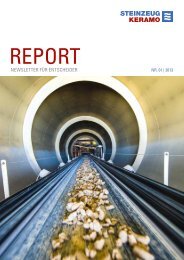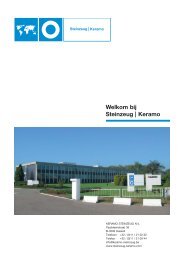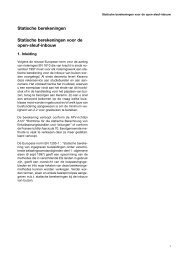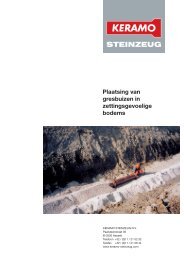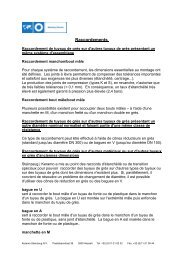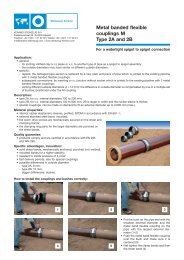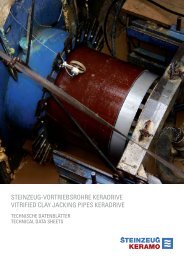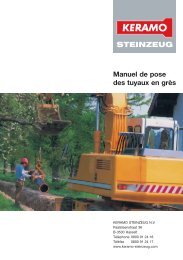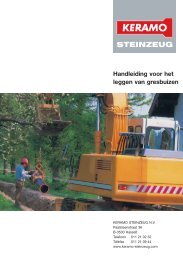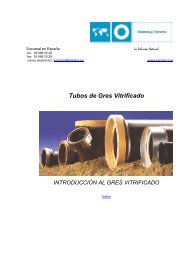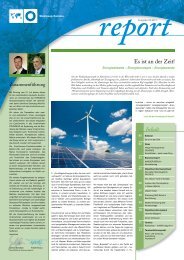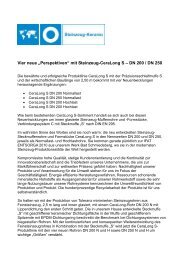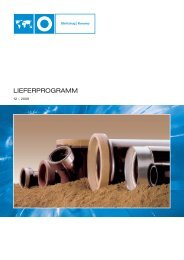mohring engels.indd - Keramo Steinzeug
mohring engels.indd - Keramo Steinzeug
mohring engels.indd - Keramo Steinzeug
You also want an ePaper? Increase the reach of your titles
YUMPU automatically turns print PDFs into web optimized ePapers that Google loves.
2. The advantages of micro-tunnelling<br />
Pipe-jacking systems are distinguished by a high level of<br />
mechanisation and therefore require substantially less<br />
manual work than conventional open sewer construction.<br />
From the fact that thrust boring is possible with<br />
concentrated rather than linear construction sites as<br />
with open methods derive the many advantages, with in<br />
some cases substantial economic and environmentrelevant<br />
consequences.<br />
The surface is generally disturbed only at the starting,<br />
target and intermediate shafts or by-shafts. Breaking-up<br />
of the road surface and subsequent restoration with the<br />
associated disruption of traffic is thereby minimised.<br />
Previous relaying of other pipes or underground installations<br />
along or close to intersections with open utility<br />
trenches for sewer construction can be reduced. The<br />
starting shaft, normally covered by the thrust-boring<br />
container, guarantees that work is noise-free and independent<br />
of the weather.<br />
Because of local topography there are often hardly any<br />
differences in level between drainage areas; some<br />
sewers must then be laid at greater depths. With open<br />
construction greater depth is thus accompanied not only<br />
by costly trench sheeting but also by substantial soil<br />
excavation. In towns and densely-populated built-up<br />
areas the excavated soil can seldom be accommodated<br />
in the immediate vicinity of the construction sites, which<br />
may give rise to long transport distances with multiple<br />
loading and unloading. Frequently, too, the excavated<br />
soil cannot be put back again if the requisite degree of<br />
compaction in the road base cannot be attained with it.<br />
In many cases neither the broken-up roadway material<br />
nor the excavated soil may be removed for use at the<br />
contractor’s discretion; both may constitute building<br />
waste which must then be conveyed to listed landfill<br />
sites. Appropriate tests with evidence of suitability must<br />
be performed.<br />
Construction of utility trenches is very expensive anyway,<br />
and is made even more so by the aforementioned<br />
requirements. Calculation of the cost shares for constructing<br />
12,252 metres of DN 200 and DN 250 sewers<br />
in 14 construction projects in Berlin-Heiligensee and<br />
Tegelort in 1983 and 1984 at a figure of about DM 9.2<br />
million (excl. VAT) showed that, taken together, lining<br />
such trenches, excavating and transporting the soil, any<br />
necessary soil replacement, landfill charges incurred,<br />
backfilling and compacting the trench and removing the<br />
sheeting made up some 39% of the construction costs.<br />
About another 31% must go on breaking up and eventually<br />
restoring the road (Fig. 2). This means that,<br />
cumulatively, some 70% of the costs incurred in open<br />
construction have nothing to do with sewer installation<br />
proper and are thus economically questionable.<br />
■<br />
■<br />
■<br />
■<br />
■<br />
■<br />
■<br />
■<br />
■<br />
■<br />
■<br />
39 %<br />
6 %<br />
63 %<br />
Micro-tunnelling Page 7<br />
Fig. 2: Cost shares for DN 200 and DN 250 domestic/industrial<br />
sewer construction by open method<br />
3 % Site equipment<br />
8 %<br />
14 %<br />
31 %<br />
7 %<br />
31 % Breaking up and restoring road<br />
8 %<br />
3 %<br />
12 %<br />
39 % Sheeting, bridges, excavating and replacing<br />
soil, backfilling<br />
8 % Dewatering<br />
7 % Manholes<br />
12 % Sewers, junctions and laterals<br />
Fig. 3: Cost shares for DN 200 and DN 250 domestic/industrial<br />
sewer construction by enclosed method<br />
9 % Site equipment<br />
8 % Breaking up and restoring road<br />
9 %<br />
14 % Sheeting, bridges, excavating and replacing<br />
soil, backfilling<br />
6 % Dewatering<br />
63 % Sewers, junctions and laterals



